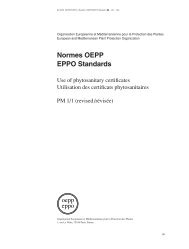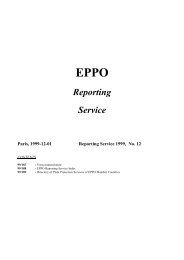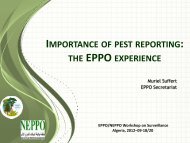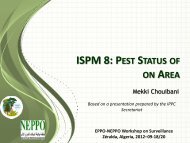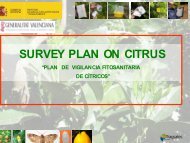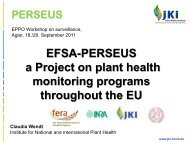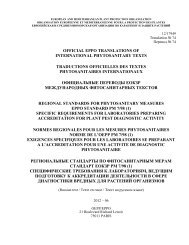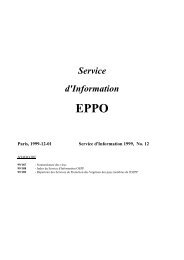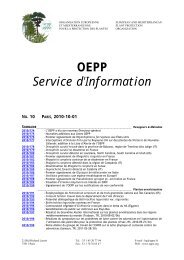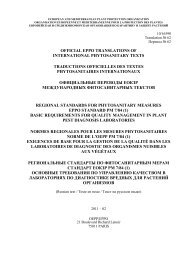EPPO Reporting Service - Lists of EPPO Standards - European and ...
EPPO Reporting Service - Lists of EPPO Standards - European and ...
EPPO Reporting Service - Lists of EPPO Standards - European and ...
Create successful ePaper yourself
Turn your PDF publications into a flip-book with our unique Google optimized e-Paper software.
<strong>EPPO</strong> <strong>Reporting</strong> <strong>Service</strong> – Pests & Diseases<br />
that form a fairly distinct F pattern near the wing tip. Larvae are creamy white<br />
<strong>and</strong> attain approximately 7 mm length at maturity.<br />
Pictures can be viewed on the Internet:<br />
http://www.insectimages.org/browse/subthumb.cfm?sub=7967<br />
http://bugguide.net/node/view/36888/bgimage<br />
S. longipennis has one generation per year. Female lay eggs (white, elongated, 1<br />
mm long) in the stem tissue <strong>of</strong> young plants <strong>and</strong> larvae feed in the stem pith<br />
tissue. Larvae develop though 3 instars before pupation takes place. The insect<br />
usually overwinters as larvae in plant debris in the soil, but in regions such as<br />
Manitoba <strong>and</strong> Ontario (CA), observations have shown that larvae leave the plant<br />
at the end <strong>of</strong> summer <strong>and</strong> enter the soil where they overwinter as pupae.<br />
Dissemination Adults are reported as strong fliers but no data is available on their potential for<br />
natural spread. Over long distances, sunflower plants, soil <strong>and</strong> eventually cut<br />
flowers may transport the pest. Seeds are not considered as a likely pathway.<br />
Pathway Plants for planting, cut flowers <strong>of</strong> host plant species, soil <strong>and</strong> growing medium<br />
(no data is available to evaluate the possibility that tubers <strong>of</strong> H. tuberosus with<br />
adhering soil could transport the pest).<br />
Possible risks Sunflower (Helianthus annuus) is native to the Americas. In the <strong>EPPO</strong> region, it is<br />
an economically important crop which is widely grown for agricultural purposes<br />
(oil, seeds, animal feed, bi<strong>of</strong>uel) <strong>and</strong> to a lesser extent for ornamental purposes.<br />
The cultivation <strong>of</strong> other Helianthus species, such as H. tuberosus (Jerusalem<br />
artichoke), is <strong>of</strong> much lesser economic importance. In North America, S.<br />
longipennis is usually considered as a minor pest but it may be possible that its<br />
populations are kept under economic threshold by natural enemies (e.g.<br />
parasitoids like Coptera strauziae (Hymenoptera: Diapriidae)) or insecticide<br />
treatments targeting other pests (e.g. sunflower beetle Zygogramma<br />
exclamationis (Coleoptera: Chrysomelidae), absent in Europe). Although, there<br />
are still uncertainties about the potential <strong>of</strong> damage <strong>of</strong> S. longipennis to<br />
sunflower crops in Europe (as very high populations are needed to cause stem<br />
breakage <strong>and</strong> lodging), it is desirable to avoid its spread within the <strong>EPPO</strong> region.<br />
It can be noted that in the <strong>EPPO</strong> region, sunflower crops are subject to a limited<br />
number <strong>of</strong> insect pests which usually do not require specific treatments <strong>and</strong><br />
therefore, it is highly desirable to maintain this rather favourable situation.<br />
Source(s) Allen WR, Westdal PH, Barrett CF, Askew WL (1954) Control <strong>of</strong> the sunflower maggot, Strauzia<br />
longipennis (Wied.) (Diptera: Trypetidae) with demeton. Report <strong>of</strong> the Entomological Society <strong>of</strong><br />
Ontario, 53-56 (abst.).<br />
Axen HJ, Harrison JL, Gammons JR, McNish IG, Blythe LD, Condon MA (2010) Incipient speciation in<br />
Strauzia longipennis (Diptera: Tephritidae): two sympatric mitochondrial DNA lineages in Eastern<br />
Iowa. Annals <strong>of</strong> the Entomological Society <strong>of</strong> America 103(1), 11-19.<br />
Brückner C, Korneyev SV (2010) Strauzia longipennis (Diptera: Tephritidae), an important pest <strong>of</strong><br />
sunflowers recorded for the first time in the Palaearctic Region. Ukrainska Entom<strong>of</strong>aunistyka 1(1),<br />
55-57.<br />
Charlet LD, Brewer GJ (2009) Sunflower Insect Pest Management in North America. In: Radcliffe EB,<br />
Hutchinson WD, Cancelado RE (eds). Radcliffe’s IPM World Textbook.<br />
http://ipmworld.umn.edu/chapters/charlet2.htm. University <strong>of</strong> Minnesota, St Paul (US).<br />
Charlet LD, Brewer GJ, Beregovoy VH (1992) Insect fauna <strong>of</strong> the heads <strong>and</strong> stems <strong>of</strong> native sunflowers<br />
(Asterales: Asteraceae) in Eastern North Dakota. Environmental Entomology 21(3), 493-500.<br />
Foote RH, Blanc FL, Norrbom AL (1993) H<strong>and</strong>book <strong>of</strong> the fruit flies (Diptera: Tephritidae) <strong>of</strong> America<br />
North <strong>of</strong> Mexico. Cornell University Press (US), 571 pp.<br />
Rogers CE (1988) Insects from native <strong>and</strong> cultivated sunflowers (Helianthus) in Southern latitudes <strong>of</strong><br />
the United States. Journal <strong>of</strong> Agricultural Entomology 5(4), 267-287.<br />
Steyskal GC (1986) Taxonomy <strong>of</strong> the adults <strong>of</strong> the genus Strauzia Robineau-Desvoidy ‘(Diptera,<br />
Tephriticae) Insecta Mundi 1(3), 100-117.<br />
Sutton BD, Steck GJ (2005) An annotated checklist <strong>of</strong> the Tephritidae (Diptera) <strong>of</strong> Florida. Insecta<br />
Mundi 19(4), 227-245.<br />
Westdal PH, Barrett CF (1960) Life-history <strong>and</strong> habits <strong>of</strong> the sunflower maggot, Strauzia longipennis<br />
(Wied.) (Diptera: Trypetidae), in Manitoba. Canadian Entomologist 92(7), 481-488 (abst.).<br />
Westdal PH, Barrett CF (1962) Injury by the sunflower maggot, Strauzia longipennis (Wied.) (Diptera:<br />
Trypetidae), to sunflowers in Manitoba. Canadian Journal <strong>of</strong> Plant Science 42(1), 11-14.<br />
INTERNET (last accessed in 2011-02)<br />
The Connecticut Agricultural Experiment Station. Sunflower (Helianthus). Plant health problems.<br />
http://www.ct.gov/caes/cwp/view.asp?a=2823&q=377954<br />
9




